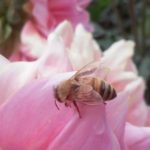 Busy bees, zippy hummingbirds, moody moths and other pollinators may rest this season or head south. Or not! You may have a few hummingbirds in your yard year round. As our gardens rest, too, we are featuring 10 Fun Facts about how amazing these creatures truly are. Here’s a random year’s end appreciation for the hard work of our varied pollinating friends.
Busy bees, zippy hummingbirds, moody moths and other pollinators may rest this season or head south. Or not! You may have a few hummingbirds in your yard year round. As our gardens rest, too, we are featuring 10 Fun Facts about how amazing these creatures truly are. Here’s a random year’s end appreciation for the hard work of our varied pollinating friends.
Pollinators eat the pollen for protein (tiny steak dinners!) and drink nectar for energy.
Most flowering plants require an insect or animal to move pollen (the male sex cells) to the female flowers.
Watermelons need up to 1000 grains of pollen deposited on each flower in only a few hours’ time.
30% of our diet relies on pollination including favorites like apples, almonds, blueberries, melons, plums and squashes.
Bats pollinate mangos, bananas and guavas!
Bees fly around 7 mph and beat their wings 190 times per second.
A midge no bigger than a pinhead is responsible for the worlds’ supply of chocolate.
Bumble bees are the best pollinators of tomatoes because only they can shake the flower in just the right way to release pollen.
Fig flowers hide inside the fruit and require a specific tiny wasp to crawl in and pollinate as they feed.
Some freaky pollinators: a Madagascar moth with an 11″ tongue; an Ecuadorian bat with a tongue longer than its body; and a flower which holds flies captive for 24 hours before releasing them.
Join the Million Pollinator Garden Challenge by registering your garden at www.millionpollinatorgardens.org or visiting Twitter #Pollination.
Follow us in Social Media